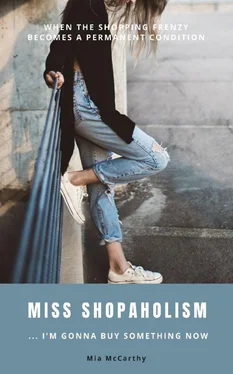Miss Shopaholism ...
I'm Gonna Buy Something Now:
When The Shopping Frenzy Becomes A Permanent Condition
(Fight Shopping Addiction)
Reproduction, translation, further processing or similar actions for commercial purposes as well as resale or other publications are not permitted without the written consent of the author.
Copyright © 2018 – Mia McCarthy
All rights reserved.
Fighting shopping addiction: What to do when shopping becomes addiction?
Forced to spend money: Psychological causes
Lack of self-esteem
Strokes of fate
Occurrence with other diseases
Hormones as cause
The compulsion to shop: Symptoms of shopping addiction
Characteristics of buying addiction
Withdrawal symptoms
Differences in purchasing behaviour
Getting a shopping addiction under control: How to combat shopping addiction?
Insight into buying addiction itself
Shopping addiction is an addictive disorder
First aid for buying addiction: How shopaholics learn to control themselves
First aid measures
Debt due to buying addiction
Outpatient behavioural therapy
Self-help groups
The first important step in the fight against buying addiction is the insight that
Fighting shopping addiction: What to do when shopping becomes addiction?
For most people, shopping is an everyday activity that is associated with either fun or stress and serves the purchase of goods and products. Usually the motivation behind the purchase of a certain product is mostly the necessity to need it. This applies, for example, above all to food, but also to clothing. Entertainment products such as televisions and books are not vital, but are socially recognized as part of everyday necessities.
As a rule, people often buy more products than they actually need. The phenomenon can often be observed in women who buy more clothes than they actually need on so-called shopping tours. This behaviour is in most cases completely unproblematic and is even demanded and promoted by society. It is not for nothing that today's society can be characterized as a consumer society. However, those who begin to compulsively purchase goods in the knowledge that they do not need them at all and thereby exceed their financial limits suffer from a buying addiction.
Buying addiction is referred to in specialist circles as oniomania, the buying delusion, but compulsive buying behaviour, compulsive buying, pathological buying addiction or the colloquial buying frenzy are terms for a buying behaviour exceeding the normal level. The phenomenon of pathological buying madness has been described for over 100 years. However, this clinical picture has not yet been fully addressed and scientific research has so far only been carried out on a small scale. The ICD (International Statistical Classification of Diseases and Related Health Problems), the reference work for mental disorders, does not list shopping addiction. The very terms that are used synonymously for compulsive shopping behaviour clearly indicate that shopping addiction has not yet been clearly classified. It is well known that the competent authorities do not work quickly, and it was not until 1968, for example, that the Federal Social Court recognised alcoholism as a disease.
Therefore, shopping addiction is not a recognized mental disorder in Germany to this day. From a medical point of view, it is counted as a non-substance-related dependency, impulse control disorder or obsessive-compulsive disorder. If a physician is forced to name shopping addiction as a diagnosis, he must in most cases select the ICD code F63.9 "unspecified abnormal habits and impulse control disorders". These impulse control disorders and obsessive-compulsive disorders also include gambling addiction and kleptomania. In the case of an impulse control disorder, those affected are not in a position to withstand an impulse and give in to it in awareness of possible negative consequences. In Germany, it is estimated that 5 % of the population suffer from shopping addiction. How high the number of unreported cases is, however, is not known. Similarly, the group of people at risk of shopping addiction is not included in these censuses. The lack of concrete diagnostic criteria due to the lack of classification in the health care system makes it even more difficult to obtain a truly transparent number of those actually affected.
If you or an acquaintance, family member or friend suffers from buying addiction, this guide will tell you, among other things, what causes are responsible for buying addiction, how you can recognise buying addiction and how you can actively take action against it.
The shopping opportunities in the 21st century tempt many people to overconsume all kinds of goods. Shopping centres that are often open into the evening hours and advertising brochures and advertisements on every corner. In addition, bargains and sales are supposed to suggest that there is a unique opportunity that should not be missed. Shopping possibilities in the internet are still the cherry on the cream. Purchased with one click and already at home the next day. Advertising and marketing ensure that certain products promise to lead a happy and fulfilling life with exactly this purchase. Advertising is aimed at demonstrating the compelling social and psychological necessity of a particular product. The frequently used phrase "you have to treat yourself to something" is almost an absolution, why many people afford things with a clear conscience, which they neither need nor meet their financial budget. If the social media and television also show a reality in which living standards marked by luxury and expensive products belong to normality, many people feel excluded and their self-esteem diminishes. The assumption that one does not belong to society because this standard of living cannot be imitated quickly leads to ignorance of one's own financial limits. It is completely forgotten that the standards of living portrayed in the media rarely correspond to reality. Numerous unconsciously conveyed slogans or marketing campaigns in everyday life convey the message that shopping helps in every situation. What is for most people a nice change and deserved distraction, can quickly become a trap for psychologically attacked people.
Usually it is not a problem to regulate your buying behaviour accordingly and to have an awareness of whether this product is really necessary and to consciously encourage advertising to buy. Of course, everyone has bought something they knew was unnecessary when they bought it, but it may have been outrageously cheap or so fascinating and beautiful that you have to have it. At the latest, when the financial means are no longer sufficient, reason wins and further purchases are broken off - albeit with a heavy heart.
Buying addicts lack this feeling of whether they really need something. Even financial limits can be skilfully ignored. They act compulsively and experience an unbearable urge to buy something. At the beginning of this disease, there are always personal problems that are intended to distract from the addiction to shopping. Those affected are not addicted to a particular product or merchandise, but rather to the feeling that buying from them triggers it. Particularly fatal: In a consumer-oriented society, shopping addiction remains undiscovered for a long time, not least because those affected can hide their addiction for a long time. Shopping addiction is so easy to exercise, it can be hidden because it is socially recognized. The inhibitions like with drugs or alcohol, which are already stigmatized by society, are completely eliminated with shopping addiction.
Конец ознакомительного фрагмента.
Текст предоставлен ООО «ЛитРес».
Читать дальше












